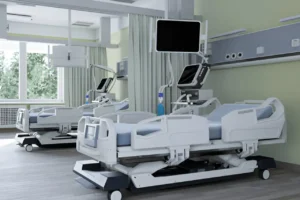Introduction
Nosocomial lower respiratory tract infections (nLRTIs), including HAP and VAP, remain a major healthcare burden due to high mortality and cost. Traditional culture methods are slow and often inconclusive. Emerging molecular diagnostics like qPCR, multiplex PCR, and metagenomic next-generation sequencing (mNGS) offer faster and more precise pathogen detection, though challenges like high costs and result interpretation remain. Non-invasive tools like breath analysis and biomarker profiling show potential but need further validation. Combining molecular, traditional, and host-response approaches is key to accurate diagnosis, timely treatment, and combating antimicrobial resistance.
Etiological Pathogens in nLRTIs
Nosocomial lower respiratory tract infections (nLRTIs) are mainly caused by a broad range of Gram-positive and Gram-negative bacteria, including multidrug-resistant (MDR) organisms, while fungal and viral causes are less common and usually affect immunocompromised or ventilated patients. The type of pathogens varies based on factors like geography, patient condition, ICU stay, mechanical ventilation, prior antibiotic use, and local microbial ecology. According to the SENTRY Antimicrobial Surveillance Program, Pseudomonas aeruginosa and Acinetobacter spp. are more prevalent in ventilator-associated pneumonia (VAP), while Staphylococcus aureus is more common in hospital-acquired pneumonia (HAP). Guidelines from major societies such as IDSA (Infectious Diseases Society of America), ATS (American Thoracic Society), ERS (European Respiratory Society), ESICM (European Society of Intensive Care Medicine), ESCMID (European Society of Clinical Microbiology and Infectious Diseases), and ALAT (Asociación Latinoamericana del Tórax) help identify MDR risk factors. Fungi like Candida spp. and Aspergillus spp., and viruses such as RSV (respiratory syncytial virus), HSV (herpes simplex virus), and CMV (cytomegalovirus), may contribute to infections, especially in high-risk patients.
Microbiological Diagnosis: From Conventional to Advanced Methods
Clinical Samples for Microbiological Diagnosis
Approaches to diagnosing nosocomial lower respiratory tract infections (nLRTIs) vary across guidelines. The ATS/IDSA (American Thoracic Society/Infectious Diseases Society of America) recommends simpler, cost-effective endotracheal aspirates (ETAs) with semi-quantitative cultures, while the European ERS/ESICM/ESCMID/ALAT (European Respiratory Society and related bodies) prefers more accurate but complex bronchoalveolar lavage (BAL) with quantitative cultures. Though BAL improves diagnostic precision, it hasn’t consistently shown better patient outcomes and may not be feasible everywhere due to cost and complexity. ETAs are easier but risk false positives or missed infections. The ideal approach should be tailored based on patient condition, resource availability, and local antimicrobial resistance, balancing diagnostic accuracy with practicality and patient safety.
Conventional Microbiological Diagnosis Methods
Diagnosing nosocomial lower respiratory tract infections (nLRTIs) is challenging, as many cases lack an identifiable pathogen. Traditional methods include collecting lower respiratory samples via invasive or non-invasive techniques, followed by Gram stain and culture to distinguish infection from colonization. Gram stain offers quick results and helps guide early antibiotic decisions, though its positive predictive value is limited and should not be solely relied upon. Quantitative cultures, often used with invasive methods like BAL, offer higher specificity and help reduce unnecessary antibiotic use but demand more resources and haven’t consistently shown better clinical outcomes.

Figure 3. Differences between semi-quantitative and quantitative culturing in the microbiologic diagnosis of nRLTIs.
Semi-quantitative cultures, used mainly for non-invasive samples like endotracheal aspirates, classify bacterial growth levels (e.g., none to heavy) without precise CFU counts. They’re quicker and resource-friendly but less specific than quantitative cultures, increasing the risk of antibiotic overuse. IDSA/ATS guidelines favor non-invasive sampling (ETAs) with Gram stain and semi-quantitative cultures for HAP and VAP, while European guidelines recommend pre-antibiotic quantitative sampling (e.g., BAL, PSB) for better accuracy. Challenges in nLRTI diagnosis include polymicrobial samples and over-reliance on empirical antibiotics, risking resistance. Other useful tests include urinary antigens (for Legionella and S. pneumoniae), blood cultures (limited ICU use), and fungal diagnostics like KOH stain, GM detection, and AspLFD in immunocompromised patients.
Advances in Molecular and Metagenomic Diagnostics
Advanced microbiological diagnostics in nLRTIs have evolved with molecular and metagenomic techniques, complementing traditional methods. Molecular tests like PCR and multiplex panels provide rapid and accurate pathogen detection, especially for fastidious organisms, but they still rely on cultures for confirmation. Metagenomic next-generation sequencing (mNGS) offers broad pathogen detection, including rare and fastidious species, and is cost-effective with reduced turnaround times. However, mNGS results can be challenging to interpret due to false positives, difficulty distinguishing infection from colonization, and lack of standardized thresholds. A hybrid approach integrating mNGS and culture methods is recommended for optimal results. Future research should focus on standardizing mNGS protocols and improving data interpretation using machine learning to enhance clinical application.
Biomarkers and Proteomics in the Diagnosis of nLTRIs
Biomarkers like C-reactive protein (CRP), procalcitonin (PCT), and soluble triggering receptor expressed on myeloid cells (sTREM-1) are valuable in managing infections, including nosocomial lower respiratory tract infections (nLRTIs), but their use is not standardized. These biomarkers help with antimicrobial decision-making, especially in critically ill patients, by indicating infection progression and treatment response. PCT is particularly useful for differentiating bacterial infections. Advanced omics technologies, such as genomics and proteomics, hold potential for improving diagnosis and prognosis. Multimarker models, like the Bioscore, offer better diagnostic accuracy than single biomarkers. Proteomic analysis of BAL fluid also aids in distinguishing between acute lung injury and ventilator-associated pneumonia (VAP). However, more evidence is needed to confirm the predictive reliability of biomarkers, and a combination of genomic, proteomic, and metabolomic approaches may improve outcomes.
Integration of Gene Expression Profiles in the Diagnosis of nLTRI
Genomic detection methods are crucial for identifying genetic factors and gene expression profiles linked to the development of nosocomial lower respiratory tract infections (nLTRIs). These profiles can predict infection onset before symptoms appear. High-throughput technologies like microarrays help identify differentially expressed genes, offering insights into host responses. In ventilator-associated pneumonia (VAP), specific genes are downregulated, indicating immune dysfunction, while others are overexpressed, increasing infection susceptibility. In hospital-acquired pneumonia (HAP), changes in gene expression affect immune response and leukocyte adhesion. Transcriptomic studies have identified gene signatures that differentiate VAP from other lung infections, with AI and next-generation sequencing improving early diagnosis and patient stratification in ICUs. Further research is needed to optimize nLTRI diagnosis and management.
Other Innovative Microbiological Diagnostic Methods for nLRTIs
Exhaled-breath analysis is a non-invasive technology for diagnosing respiratory infections, including hospital-acquired pneumonia (HAP). It detects volatile organic compounds (VOCs) produced by microorganisms through metabolic processes. The electronic nose (e-nose), which identifies VOC patterns linked to specific pathogens, shows promise in differentiating bacteria like Staphylococcus aureus, Escherichia coli, and Candida albicans. Machine learning enhances this technology by distinguishing viral from bacterial infections. While the e-nose offers portability and rapid detection, its diagnostic accuracy can be affected by comorbidities and multiple infections. Combining it with techniques like gas chromatography may improve its sensitivity and specificity. Further validation is needed for reliable clinical use.
Expert Opinion
The rapid identification of pathogens in non-lower respiratory tract infections (nLRTIs) is critical for guiding effective antimicrobial therapy and improving patient outcomes. Current diagnostic methods face challenges, including delays in specimen processing, which can lead to inappropriate antibiotic use. Molecular techniques like PCR offer quicker results than traditional cultures but are limited by pathogen panels and difficulty differentiating between colonization and active infection. Metagenomic next-generation sequencing (mNGS) shows promise for identifying a wide range of pathogens, but its complexity, cost, and lack of standardized guidelines restrict its clinical use. Non-invasive methods, like exhaled-breath analysis using e-nose technology, are also emerging but require further refinement and validation. Biomarkers and gene expression profiles hold potential, but variability and complexity hinder their clinical implementation. A multimodal approach combining molecular, proteomic, and AI-based tools could enhance diagnostic accuracy and improve treatment outcomes. To maximize their clinical utility, these technologies need standardization, cost reduction, and integration with traditional methods.




